I’m pretty good at keeping secrets. I’m so good at it people actually send me death threats. If you have a secret, you can tell me. I won’t tell anyone. Go ahead. I’m listening.
Over the past few months, I’ve been the vessel for a couple of very exciting secrets and it’s been really hard to not give someone the nudge-nudge-wink-wink-don’t-tell-anyone, but I couldn’t. Not these.
The first is the re-release of The Secret of Monkey Island. Several months ago I was invited to LucasArts to get a sneak preview. Very cool.
Hopefully this will open up the pure pleasure that is Monkey Island to a whole new generation of gamer that knows only how to use a console controller.
The second secret is that TellTale is doing an episodic version of Monkey Island. I had the great pleasure of spending a few days with Dave Grossman, Mike Stemmle and the rest of the TellTale crew getting my head into Guybrush Threepwood again.
I am very exited for both of these games. It’s strange and humbling to see something you created 20 years ago take on a life of it’s own.
This next year is going to be very interesting. Ron Gilbert, Dave Grossman and Tim Schafer all have games coming out. Someone check the scriptures. Might be a good time to start hoarding canned goods.
About a year and a little more ago, as I began designing the uber-awesome DeathSpank, I played all the way through The Secret of Monkey Island to refresh myself on the puzzles and dialog.
I know this will come as a shock to many of you, but I don’t spend my evenings playing through Monkey Island. It’s probably been 15 years since I sat down and really played it.
Much like the experience of watching the Maniac Mansion Speed Run, it bought back a lot of memories and little tid-bits of facts, so I started keeping notes and in celebration of all things Monkey Island, I thought I’d share them.
Before we begin, a couple of points:
-
Some of this I’ve written about before, so I apologize if I’m wasting your time.
-
I was playing the VGA version that was released after the original EGA version. The original original version used 16 colors and the inventory was text only.
-
These are only “some-what” in order.
-
You may disagree with me on some of these, and that’s perfectly OK. My life is forever intertwined with this game and some of these are more reflective than anything else.
-
It’s been almost 20 years. My brain is full.
If anyone has specific questions about Monkey Island 1 or 2, feel free to ask them in the comments or send them to me. If the answer contain interesting information or fuels a good story, I’ll add it to this list.
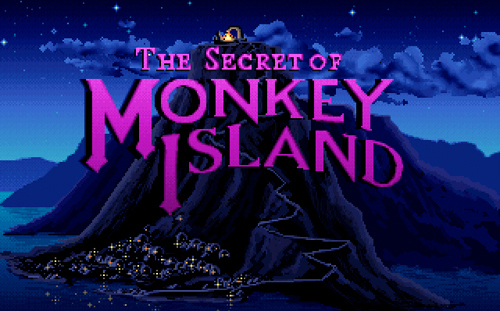
Someone please turn off the lights, and I’ll start the projector.
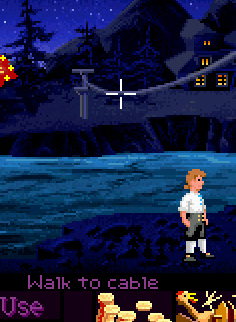
The very small “hot spot” areas are very annoying today but they were accepted back then; they were even considered a good thing. It’s called Game Play! It would be hard to make an adventure game today where players were forced to hunt for small objects.
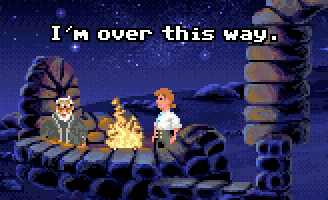
Most people know you can hit the period key to skip a single line of dialog, but I’m surprised when I run into people that don’t know why I chose the period key. It seems obvious to me: a period ends a sentence.
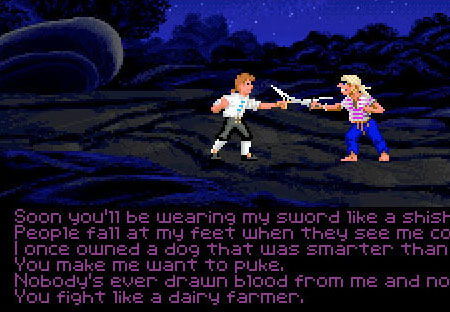
While Insult Sword Fighting is one of the first things people think of when they hear Monkey Island, I thought it seemed little tedious (but fun) as I played though it again. There is a point where you say “I get it”, but your still forced to go though the motions again and again. If I was going to do Insult Sword Fighting in a future game, I’d make it more free form allowing the player to be clever and construct their own sentences.
During the early stages of the Monkey Island design, we would watch old Errol Flynn era pirate movies. One thing that stood out was during the fights they always taunted each other with insults. I knew we needed to have sword fighting in the game - it was about pirates after all - but I didn’t want to introduce any action game play and the old pirate moves provided the perfect solution.

Back in the late 80’s, the mere thought of a scroll wheel on a mouse would have been crazy talk, but today I found it hard to break the habit of trying the scroll the inventory with it.
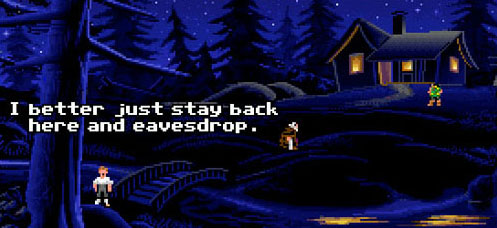
You only have to follow the shop keeper to the Sword Master once, after that it’s just automatic. That was a good design choice. No point in having to solve the same puzzle over and over.
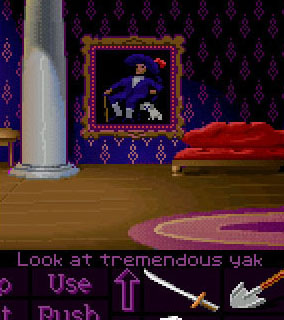
Scene behind the walls of the governors mansion seemed a little long. The original plan was to have real game play and puzzles, but the game was feeling too big and we need to cut stuff. This gag was perfect, and in some ways better then making the player solve more puzzles. Never be afraid to edit you game down if it needs it. It will often be better for it. Except this went on too long.

“Ahoy there, Fancy Pants” is my favorite throw-away line ever.
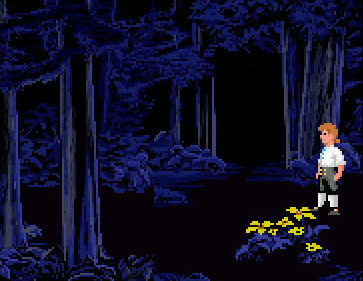
Back then, the randomly generated forest was cutting edge technology. Disk space was at a premium. Everything had to fit on 5 floppy disks. Sierra would ship games on 8 or 10 floppy disks. That was always a sore point for us.
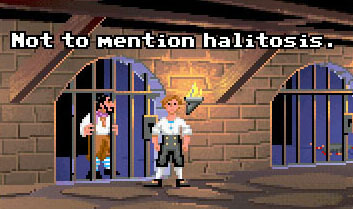
I like the way you meet Otis, Sword Master and Meathook during regular puzzles, then hire them later. Builds a sense of friendship before they are needed. They aren’t just three random people you meet for the first time while look for a crew.
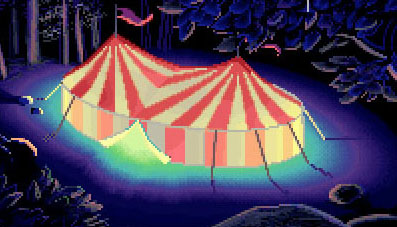
The circus tent could have been more utilized. Bit of a waste for one puzzle and the Fettucini Brothers didn’t add much to the story. That said, this was one of the first screens (“rooms” as we called them) where we used the SCUMM system’s exclusive scrolling screens for dramatic effect. Tim was the programmer on this room and he spent a lot of time getting it to scroll at just the right time to revel the tent. I also like that the dialog choices are shown up up-side-down after Guybrush is shot from the cannon. Doing that pushed the SCUMM system to utilize multiple fonts. We didn’t have that feature before this gag required it. Guybrush being shot out of the canon was also foreshadowing for later when he needed to be shot out of the canon. OK, come to think of it, this was a pretty useful room.
CORRECTION: It is July 21, 2022 and Dave Grossman informs me it was he who worked on the circus.
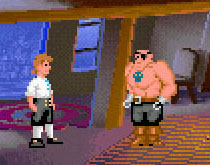
Touching the parrot puzzle was a little lame and linear. I remember being rushed and we couldn’t think of anything better. The game was feeling good and long already, so I just punted on this puzzle.
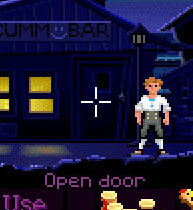
UI for having to open and close doors independently from walking though them was obnoxious. You’d never do this in an adventure game today, but like pixel hunting, it was accepted.
Something I added to the Humongous Entertainment adventure games was the cursor changing into a big arrow when you hit the edge of the screen and it was an exit. Monkey Island would have benefited from this. I was so used to it from the Humongous games that I’d scan the screen expecting to see it over exits.
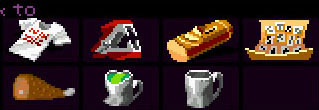
OK, I’m going to admit that I was completely stumped by the grog puzzle. I finally went and looked it up on the internet. That’s a damn good puzzle. I found several puzzles would give me pause because I’d remember some previous unimplemented version of them and it would throw me off track. My brain is filled with a lot of old adventure game puzzles, most of which never made it into a game. DeathSpank actually has a couple of puzzles ideas that we talked about for the original Monkey Island.
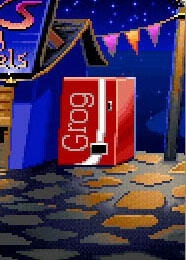
Stan’s Grog machine was one of three interesting lessons was I given about trademarks and copyright during the production of Monkey Island. Originally, I wanted the Grog Machine to be a Coke Machine, baring that, I wanted it to look like a Coke machine. It originally had the “Coke Wave” on it, but said “Grog”. The Lucasfilm legal team came back and said it was too close to the real trademarked Coke Wave. I tried to argue Parody to no avail. We kept changing it little by little until legal was satisfied it didn’t look too much like a Coke machine.
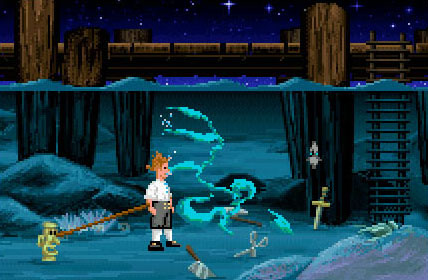
Getting stuck on the Ocean floor is one of my favorite puzzles because the solution is so obvious most people overlook it. The other puzzle I did in this same vane was in Indiana Jones and the Last Crusade adventure game where Indy has to have faith and just walk over a ledge. Players that had faith and just clicked on the other side of the crevice had no problem. Players that fiddled around and clicked on other stuff, ignoring the advice, always fell.
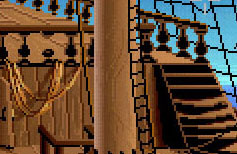
I forgot about the ladder to get the pirate flag for the soup. I kept focusing on Meat Hook’s tattoo, which was something we talked about during the early design.
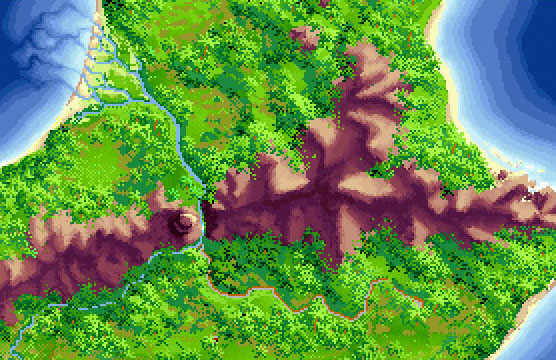
I had wanted the time you spent on Monkey Island to feel more like a RPG, which is why you had top-down view. As the game progressed, I slowly scaled back those plans, but we were still left with these very cool maps. I love maps. For me a game design always starts with a map.
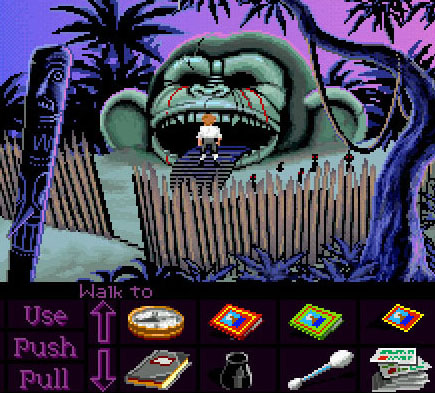
The key to the Monkey Head used to be called a Q-Tip(tm), but in my second legal lesson of the project it was changed. According to our legal advice, it would have been OK if we were using the Q-Tip in a “correct fashion”, but taking a giant Q-Tip and sticking it into a stone monkey’s ear is not “correct usage”. Interestingly enough, a Q-Tip box states: “Do not insert cotton swab into ear canal”. I think we were doing just that.
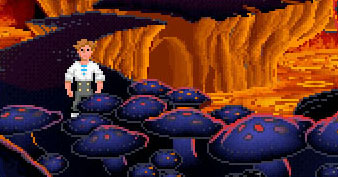
“I had a feeling in hell here would be mushrooms” was one of Tim’s lines. Tim hates Mushrooms. I also hate mushrooms, but unlike Tim, I’m happy to pick them out.
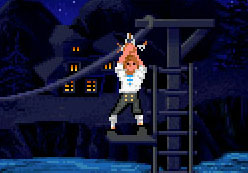
We called them “Special Case Animations”. The first SCUMM game they appeared in was The Last Crusade and then used to an amazing (well, amazing for 1990) extent in Monkey Island. Each of the “actor” sprites had a set of basic animations that including standing, walking, talking, picking up and reaching. If we need an animation that would only be used on one place, it was called a Special Case Animation and each one was carefully considered due to the 5 floppy disk limit. Every pixel had to count.

Begging for the necklace from the head of the navigator is a bad puzzle. It’s too easy for players to think they’re on the wrong path.

After getting the root, we didn’t make the player walk all the way back to the cannibals then all the way to the ghost ship. There was much discussion about this. I think we made the right decision.
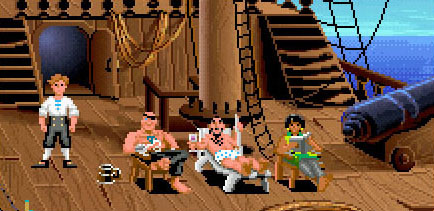
For the most part, Monkey Island is fairly open ended allowing players a lot of freedom to explore and solve several puzzle threads at a time, but there are two big choke points where the puzzles become very self contained. The first is on the ship as you’re sailing (or trying to sail to) Monkey Island. The second is while you’re on the ghost ship. All the solutions to puzzles can be found right where you are. These were done on purpose to give the player a small break and allow them to focus on one area.
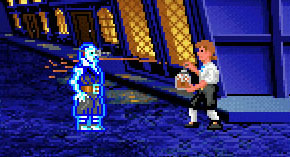
After you’ve made you way back to Melee Island, you are forced to kill two ghost pirates with your root beer. This was important because it showed not only how the root beer worked but that it would work.
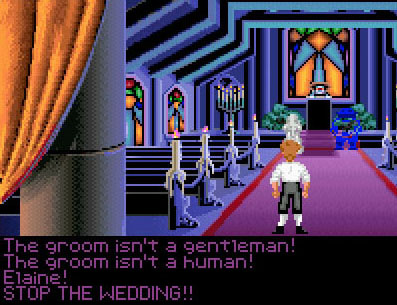
Elaine Marley was just called “The Governor” until the scene in the church was written. Dave Grossman wrote that scene and put in the gag dialog choice where Guybrush shouts “Elaine!”, which is from the movie “The Graduate”. I liked that, so it became her name. In the original design, Elaine was a more ruthless Governor, but she softened up and became a true love interested as the project processed.
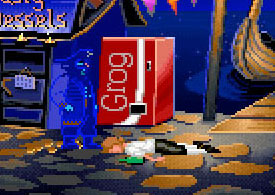
By design, the whole ending of the game is a “gimme”. The player has worked hard to get to this point, I wanted something they could just sit back and enjoy playing.

There was supposed to be ship combat during your voyage to Monkey Island. It would have been done top-down view with you controlling the ship and firing a cannon. It was right to cut that. Never be afraid to cut. It’s rare that I watch a “director’s cut” of a film that is better then the original. Most of that stuff was left out for a reason.
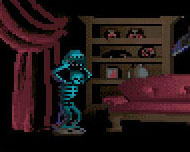
Last legal snafu we had with Monkey Island revolved about a “Look At” line in the voodoo shop. When you’d look at a statue, Guybrush would say “Looks like an emaciated Charles Atlas.” We got a cease and desist letter for that and has to change it in future versions. I don’t know for sure when version it changed in.
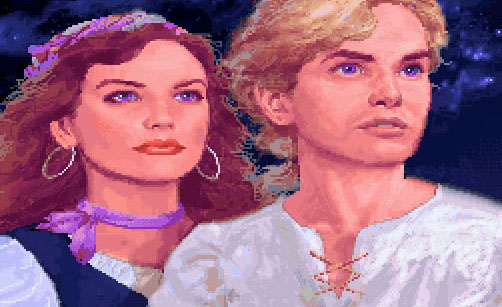
THE END
P.S. I was always bothered by these close-ups. While they were great art, I never felt they matched the style of the rest of the game. Not sure how I feel about them 20 years later.